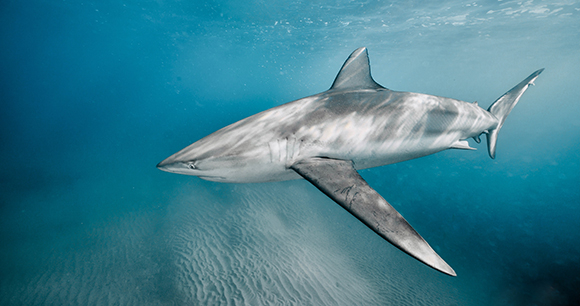
Shark fin bans and similar laws are an essential step in protecting shark populations and broader marine ecosystems. Since many shark species migrate across international borders, shark fin bans must be consistent from country to country in order to be effective. Legislative efforts within the United States have attempted to curb the brutal practice of shark finning by banning the possession, trade, and/or sale of shark fins. US shark fin bans contribute to global efforts to combat overfishing and trade of shark products, highlighting the importance of international cooperation for conservation.
Federal laws
Shark Fin Sales Elimination Act
A long-awaited victory occurred in December 2022 when the Shark Fin Sales Elimination Act passed Congress as part of the National Defense Authorization Act (HR 7776) and was signed into law by President Biden. It prohibits the sale, purchase, possession, and transport of shark fins and shark fin products. The federal ban is a significant win for animal welfare and marine ecosystems worldwide, which we hope will set an example for other nations.
The law, however, does provide for limited, narrowly defined, exceptions for lawfully taken shark fins that are
- destroyed or disposed of immediately upon separation from the carcass;
- used for noncommercial subsistence purposes in accordance with federal, state, or territorial law; or
- used solely for display or research purposes by a museum, college, or university pursuant to a federal, state, or territorial permit to conduct noncommercial scientific research.
Additionally, the law provides that “persons may possess, acquire, receive, transport, offer for sale, sell, or purchase a shark fin of a smooth dogfish (Mustelus canis) or a spiny dogfish (Squalus acanthias) shark.” The exemption does not apply to other similar looking Mustelus or Squalus shark species, such as Pacific spiny dogfish (S. suckleyi), Florida smoothhound (M. norrisi), or Gulf smoothhound (M. sinusmexicanus).
Shark Finning Protection Act
This legislation was preceded by the Shark-Finning Prohibition Act, enacted in 2000, which made it unlawful to possess a shark fin in US waters without a corresponding carcass. Unfortunately, the ban did not require that carcasses be brought ashore with fins attached, relying instead on a fin-to-carcass ratio whereby the total weight of the fins must not exceed a certain percentage of the total weight of the carcasses. This allowed fisherman to flout the law by mixing and matching bodies and fins from various sharks, making enforcement very difficult since it is nearly impossible for enforcement officials to determine what species fins are taken from once they are removed from the body. The consensus of scientists, conservationists, and enforcement officials is that the only way to effectively enforce a shark finning ban is to require that if sharks are fished, they must be brought to shore with their fins naturally attached.
Shark Conservation Act
To close this loophole, the Shark Conservation Act was signed into law in January 2011 with the goal of strengthening the nation’s shark finning ban by requiring fishermen in US waters to bring sharks ashore with fins naturally attached. The Shark Conservation Act amended the High Seas Driftnet Fishing Moratorium Protection Act and the Magnuson-Stevens Fishery Conservation and Management Act (see below). The Shark Conservation Act requires that all sharks in the United States, with one exception, be brought to shore with their fins naturally attached.
Magnuson-Stevens Fishery Conservation and Management Act
Other US laws provide some protections or provisions for sharks. Under the Magnuson-Stevens Fishery Conservation and Management Act, the National Marine Fisheries Service manages sharks in US federal waters using fishery management plans.
High Seas Driftnet Moratorium Protection Act
The High Seas Driftnet Fishing Moratorium Protection Act requires that the National Oceanic and Atmospheric Administration identify nations and entities whose vessels are engaged in illegal, unreported, and unregulated (IUU) fishing, fishing practices that result in the bycatch of protected marine life, and/or fishing activities that target or incidentally catch sharks.
Endangered Species Act
Enacted in 1973, the Endangered Species Act (ESA) was designed to protect and recover endangered and threatened species and the ecosystems upon which they rely. It prohibits the “take” of endangered and threatened species, meaning actions that harm or harass them, and requires federal agencies to consult with wildlife management services to avoid jeopardizing the survival of these species. The ESA also provides for listing species as endangered or threatened, developing recovery plans, and cooperating with states and international partners. Several shark species, including the oceanic whitetip and the scalloped hammerhead, are listed as either threatened or endangered under the ESA.
Shark fin bans in US states and territories
Prior to the passage of the SFSE Act, Hawaii, Washington, Oregon, California, Delaware, Maryland, Illinois, New York, Massachusetts, Rhode Island, Texas, Nevada, New Jersey, Florida, American Samoa, the Northern Mariana Islands, and Guam passed legislation banning the possession and/or trade of shark fins altogether within their borders.